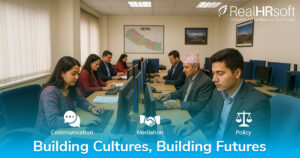Ever feel like your Nepali business is constantly battling brain drain, struggling to find the right talent, or simply not growing as fast as it should? You’re not alone! Many businesses in Nepal still treat HR as just a “paperwork department” – dealing with attendance, leaves, and payroll. But what if we told you that Hiring Right isn’t just a best practice, it’s your biggest secret weapon for explosive growth and undeniable profits?
As a seasoned Strategic HR leader, I’ve seen firsthand how a single bad hire can cost a company its very future, especially in Nepal’s unique market. Conversely, the right talent can transform a struggling venture into a market leader. This isn’t just about filling a vacancy; it’s about Strategic Talent Acquisition – a deliberate, profit-driven process that directly impacts your bottom line, market leadership, and the very future of your Nepali business.
It’s time to shift your mindset. For any forward-thinking Nepali business owner dreaming of scaling operations and leaving competitors in the dust, understanding the nuances of Nepali Talent Acquisition is non-negotiable. Forget informal interviews; it’s time for a systematic, strategic approach.
The Business Imperative: Why “Hiring Right” is Your Profit Powerhouse
In today’s relentlessly dynamic market landscape, the antiquated perception of HR as solely a function for hiring and leave management is a perilous and financially detrimental misconception. For any discerning Nepali business owner committed to achieving sustainable expansion, securing market leadership, and delivering robust financial performance, Human Resources must be re-envisioned as a pivotal strategic partner. When HR functions are seamlessly integrated into the core business strategy, they transition from being perceived as a cost center to becoming a powerful engine for innovation, adaptability, and decisive competitive advantage. This transformation transcends abstract concepts; it translates directly into quantifiable gains and underpins the very viability of the enterprise. High turnover, for instance, severely corrodes profitability, with replacement costs for a mid-level employee frequently exceeding 1.5 times their annual remuneration, directly compromising the delivery of the organizational Mission.
So, how do we strategically navigate Nepal’s unique talent landscape and ensure every HR action contributes to operational excellence, ultimately leading to profit?
Your 9-Step Strategic Compass for Talent Acquisition & Operational Alignment in Nepal: The “Hiring Right” Blueprint!
Hiring success begins before the first CV arrives. It’s about a meticulously crafted strategic blueprint that aligns with your Vision, Mission, Goals, and Objectives (VMGO).
1. Define the Role with Strategic Clarity & Operational Impact:
Strategic Aspect: Don’t just fill a seat; define the impact and how this role contributes to your overarching Vision and Mission. Clearly articulate the career path or growth opportunities available.
- Operational Alignment: Work with department heads to draft precise job descriptions and set clear performance expectations. Use tools for employee management software Nepal to track these definitions.
-
-
- Practical Tip: Before posting, conduct a “role impact workshop” with the hiring manager to define key performance indicators (KPIs) for the first 90 days.
-
2. Choose the Right Strategic Channels for Talent Acquisition:
In Nepal, not all platforms are created equal. LinkedIn is increasingly effective for managerial and specialized positions, while internal referrals are highly effective in the Nepali work culture.
- Operational Alignment: Implement recruitment management software Nepal to track source effectiveness. For critical roles, combine multiple platforms to widen your reach.
-
-
- Practical Tip: Analyze past hiring data: Which channels consistently deliver high-performing employees? Allocate more resources there.
-
3. Screen Applications Thoughtfully & Strategically for Fit:
Move beyond keywords. Focus on relevant experience, accomplishments, and look for signs of commitment, problem-solving, and adaptability. Be culturally mindful of employment gaps common in Nepal due to education or family obligations.
- Operational Alignment: Utilize digital tools and HRIS software Nepal to filter applications efficiently. Develop standardized scoring rubrics for initial resume screening.
-
-
- Practical Tip: Create a concise “pre-screening questionnaire” for high-volume roles to quickly identify candidates who meet essential strategic criteria.
-
4. Conduct Structured, Insight-Driven Interviews for Performance Prediction:
Avoid informal, instinct-based interviews. Prepare questions that delve into both technical and soft skills. Utilize situational and behavioral questions and consider practical tasks or case studies. Standardized questions ensure fairness and and allow you to understand how candidates think.
- Operational Alignment: Train hiring managers on effective interview techniques. Implement a shared interview feedback form within your HR management system Nepal.
-
- Practical Tip: For senior roles, include a “strategic challenge” exercise where candidates present a solution to a real business problem your company faces.
5. Evaluate for Cultural & Organizational Fit (The Nepali Context):
Skills can be developed, but values and attitudes are harder to change. In Nepal’s close-knit, relationship-driven work culture, cultural alignment is paramount.
- Operational Alignment: Integrate cultural fit assessments into the interview process. Define your company’s core values and communicate them explicitly during interviews.
-
-
- Practical Tip: Arrange informal meet-and-greets with team members (not just direct supervisors) to allow cultural fit to be assessed from multiple perspectives.
-
6. Verify with Strategic Reference Checks for Risk Mitigation:
Underutilized in Nepal, reference checks offer invaluable insights. Reach out to former supervisors to validate performance, reliability, and teamwork. This adds a crucial layer of confidence to your decision.
- Operational Alignment: Develop a standardized list of questions for reference checks. Document all feedback within your HR system.
-
-
- Practical Tip: Ask references about how the candidate handled specific challenges or contributed to team goals, not just general praise.
-
7. Craft a Competitive & Compelling Offer with Total Rewards:
Talented Nepali professionals often have multiple opportunities. Your offer must be clear, fair, and aligned with market expectations. Highlight not just salary but also non-monetary perks like training programs, growth opportunities, and a compelling domestic Employee Value Proposition (EVP) that counters the allure of foreign employment.
- Operational Alignment: Leverage payroll software Nepal and payroll automation Nepal to ensure accurate and timely compensation. Clearly outline benefits and growth paths in the offer letter.
-
-
- Practical Tip: Conduct regular market salary surveys (if resources allow) to ensure your compensation strategy remains competitive, using data for HR analytics software Nepal.
-
8. Deliver a Strategic, Culture-Aligned Onboarding Experience:
Hiring doesn’t end with an offer; it begins a new chapter. A structured onboarding process, integrating new hires into your company culture and Vision, improves retention and accelerates productivity.
- Operational Alignment: Develop a detailed 30-60-90 day onboarding plan. Utilize features of your HR management system Nepal for task assignment (e.g., IT setup, policy reviews). Assign a “buddy” or mentor and schedule regular check-ins.
-
-
- Practical Tip: Pair new hires with an experienced team member (a ‘dai’ or ‘didi’ – elder brother/sister in a respectful Nepali context) for informal support and cultural integration.
-
9. Reflect & Continuously Improve with Data-Driven Insights:
The best recruitment processes are never static. Track key metrics like Time-to-Hire, Cost-per-Hire, and new hire retention rates (e.g., at 90-day and 1-year benchmarks). Collect feedback from candidates and hiring managers to improve the experience. As the Nepali job market becomes more competitive, leveraging HR analytics software Nepal will keep you ahead, allowing you to learn from outcomes and refine your strategy.
- Operational Alignment: Regularly review HR dashboards from your cloud HR software Nepal. Conduct quarterly debriefs with hiring managers to discuss challenges and successes.
-
-
- Practical Tip: Implement short pulse surveys for new hires at the 1-month and 3-month mark to gather actionable feedback on the onboarding process and initial job experience.
-
Conclusion:
For Nepali business leaders unequivocally committed to scaling operations, fostering innovation, and competing effectively in a globalized marketplace, the message is unequivocal: elevate HR from a mere support function to an indispensable strategic partner. HR is the core engine that constructs resilient teams, amplifies organizational adaptability, meticulously mitigates critical business risks, and directly generates enduring shareholder value by ensuring that your entire workforce is seamlessly aligned with your Vision, Mission, Goals, and Objectives.
Investing in strategic HR is not merely beneficial for your personnel; it is fundamentally imperative for your profitability and securing your future prosperity. It is time to perceive HR not just as a department, but as the dynamic engine room of your future growth, orchestrating the precise talent strategies that will enable your business to thrive sustainably. After all, businesses don’t grow—people do. And hiring the right people, with strategic operational alignment, is where that journey begins.
Ready to transform your talent acquisition strategy and unlock unparalleled, operationally aligned growth for your Nepali business?
Reach out to us for personalized tax consulting in Nepal and expert HR consulting services!
[info@aayulogic.com] +977-9802-075555





